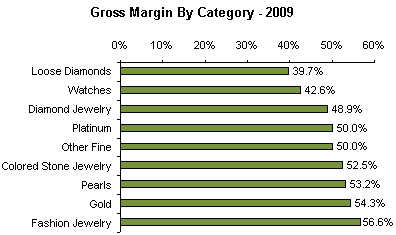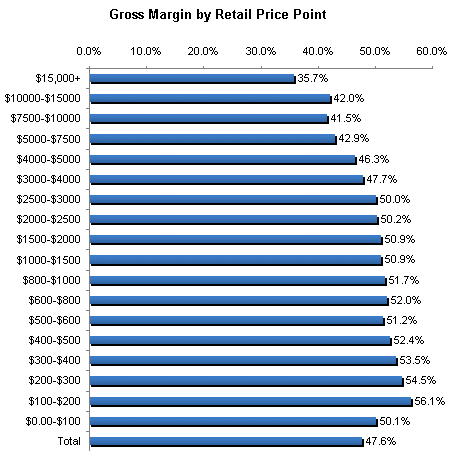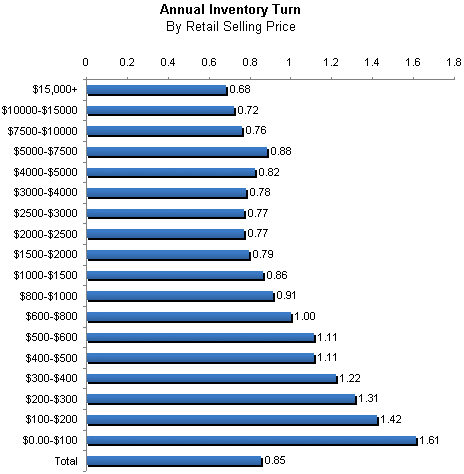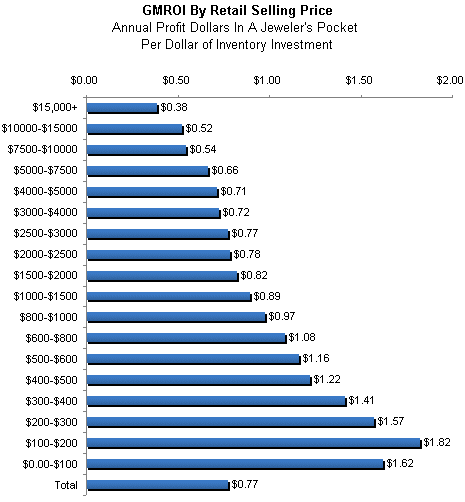IDEX Online Research: Put More Profit Dollars in Your Pocket
May 25, 10
Decisions, decisions, decisions. With the recessionary environment, coupled with a “new normal,” how can jewelers know what merchandise to carry in their stores?
If merchants have the wrong inventory, sales will plummet. If they have the right inventory, customer demand will be strong, but jewelers might risk running out of inventory.
We’ve said it a thousand times, so this will be the thousand-and-first time: the winners in the jewelry industry will be separated from the losers by information. Business information nourishes survivors; those who lack information will die from malnourishment. Think about it this way: information is the protein that nourishes your business.
Recently, Buyers International Group (BIG) provided 2009 merchandising data from a sampling of its members who use the Balance-To-Buy system (BTB). While there are other systems available to retailers, the BTB system appears to be one of the better systems which are available. Further, BTB has been the only data aggregator that has provided information to IDEX Online Research.
Making a Sound Inventory & Merchandising Decision
As part one of this article indicated, both the average ticket and sales by price point indicate that the “new normal” American jewelry shopper is buying less expensive jewelry. The BTB system, like most management information systems, provides a wealth of information by price point (unit sales, average ticket, total sales, etc.). These systems can also provide the same data by individual product categories, such as loose diamonds, diamond jewelry, colored gemstones, and virtually any category that the jewelry store owner can create (these categories are customized for each jeweler).
Merchants Start With Gross Margin
A jeweler’s profits will ultimately be affected most by an item’s gross margin – the selling price of the item less the cost of the item, expressed as a percentage. If the difference between the selling price and cost is expressed as a dollar figure, it is “gross profit,” not gross margin. Profits are dollars; margins are percentages.
The jewelry industry typically operates on a “keystone” margin – that is, merchants buy goods for $1 and sell them for $2, yielding a 50 percent gross margin (or a $1 gross profit). But, this broad sweeping statement does not reflect reality. Some goods – and some price-points – will yield better margins than other goods.
The Jewelers of America Cost of Doing Business Survey summary of gross margin by product category illustrates gross margin variance by each product category, as the following graph shows:

Source: JA
Gross Margin by Retail Price Point
An axiom in the jewelry industry is that goods which sell at higher retail prices are priced to yield a lower gross margin. The data from BIG’s BTB sample confirms this, as the graph below illustrates.

Source: Balance-To-Buy
Unfortunately, far too many jewelers operate without this information. They don’t have a systematized method for calculating or understanding their gross margins, especially by price point. If they are to be competitive, they need to understand this information.
Inventory Turn Is Important to Those in the “Business of Jewelry”
There are two kinds of jewelers. Those in the “jewelry business” love the sparkle of gemstones and precious metals over all else. Those in the “business of jewelry” love the thrill of making a profit above all else. The former will not last long in business; the latter category of merchants will be the survivors.
Most jewelers turn their inventory about one time per year, but that average is misleading. Some inventory could turn monthly, while other inventory could turn only once every two years, an unacceptable turn rate under any circumstances. IDEX Online Research has been in jewelry stores where merchants are holding inventory that is many years old, sometimes bought by the previous generation.
In one case, goods were purchased more than three decades ago by the current owner’s grandfather. Unfortunately, the current owner did not want to dishonor his grandfather by melting that old inventory that was, in reality, not going to sell to the current customer base. Our view: he’s going to dishonor his grandfather when he leads his store into bankruptcy, if he doesn’t get rid of that inventory.
There is a further complication to understanding and calculating inventory turn: “owned” inventory typically turns less than once a year. In the case of the sample from BTB, the owned inventory turn is 0.85 times annually. However, far too many jewelers include “memo” goods – merchandise on consignment – in their inventory calculation. This is misleading; bankers should require jewelers to include only owned inventory, when calculating inventory turn. Savvy jewelers who are trying to understand how their cash is being used should exclude memo goods in their inventory turn calculations, since it will yield a misleading number.
Further, we recommend that all repair, special order as well as similar goods and services be excluded from the calculation of inventory turn, since they don’t really represent owned inventory that is a part of the core business.
A management information system such as BTB and others will help merchants track their inventory turn. Properly used, these systems will help merchants generate annual inventory turn information by price-point as shown on the graph below.

Source: Balance-To-Buy
GMROI Is the Most Important Measure
While a jeweler’s gross margin and inventory turn are extremely important, the most important piece of information is a financial metric called “Gross Margin Return on Inventory Investment” or GMROI. This measure is calculated in a variety of different ways, but the basic concept involves the relationship between gross profit dollars and inventory turn. Depending on the method of calculation, some merchants express the answer in dollar terms, while others express it as a percentage. Either way, the answers are essentially the same.
We prefer to express GMROI in dollar terms, because dollars can be counted in the cash register, dollars can be touched and dollars have real meaning.
The bottom line of GMROI answers this question: How much profit does a jeweler generate on each dollar of inventory investment? This is probably one of the most powerful questions that merchants should ask themselves.
However, even the savviest merchants often stumble over GMROI, because it forces them to acknowledge that they probably have bad inventory in their stores. It may be difficult for a merchant to admit that he or she made a mistake, but the sooner that the mistake is rectified, the sooner that merchant will be back on the road to profitability.
The graph below summarizes GMROI by retail price point – expressed as a cash return on investment – for the sample of jewelers in the BTB group.

Source: Balance-To-Buy
The GMROI curve shown on the graph above is typical of an independent specialty jeweler. We would argue that GMROI should be the same for all price points, because all merchandise should generate more or less a similar return. In lieu of that, it seems to us that the slower turning, higher priced goods should yield a higher GMROI. In fact, those slow-turning, cash-eating high priced goods have the worst GMROI. If anything, this graph is upside down.
We also recommend that jewelers exclude special orders, repair revenues, and other goods from the GMROI calculation because the jewelers have no inventory investment in those goods. GMROI is used to calculate a return on invested capital. By including special orders and other non-inventoried goods, jewelers are getting false information about the return on invested capital.
Still Confused About How GMROI Works?
We still get blank looks when we mention GMROI to many jewelers. However, the following exercise will help merchants understand the concept behind GMROI.
Here’s the exercise:
· As a jeweler, you have two choices for pricing your goods.
o If you price them in the traditional way with a “keystone” margin, you will get a 50 percent margin, but you’ll be able to sell each item only one time per year (the current inventory turn for the traditional pricing model is one inventory turn annually).
o If you price the item very low – to yield a 1 percent margin, you will sell one per day – customers will be lined up to buy the item. Thus, the inventory turn will be one per day, or 365 turns per year. And jewelers would need to keep only a one-day supply in stock, especially if they use a supplier like Stuller.
o Which pricing model should the jeweler select?
· Unfortunately, too many jewelers select the traditional pricing model, and, of course, they are wrong. Here’s why:
o If a jeweler buys an item for $100 and sells it for $200 (a keystone margin) one time per year, the jeweler pockets $100 of gross profit for the year.
o However, if the jeweler buys an item for $100 and sells it for $101, and does this 365 days a year, he will pocket $265 in gross profit dollars ($365 gross profit dollars less the cost of one item in inventory at $100).
o IDEX Online Research would rather have $265 gross profit dollars rather than $100 gross profit dollars.
Convinced now?
By the way, jewelers’ bankers understand this concept: they will virtually always advocate a pricing model that would yield more cash rather than less cash.